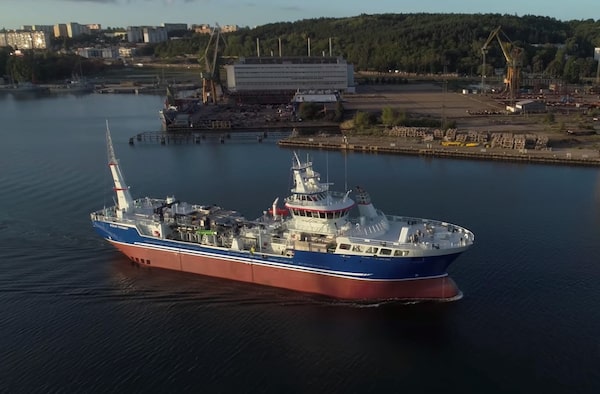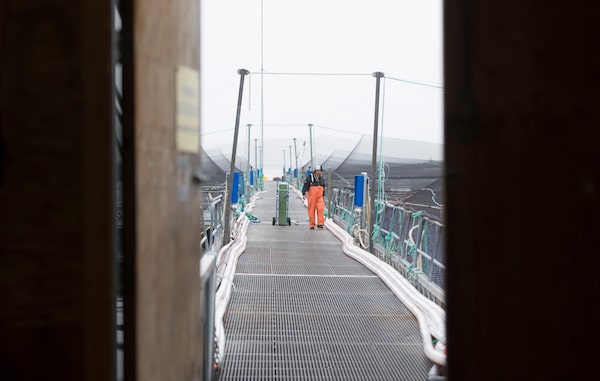
The Okisollo fish farm is pictured during a DFO fish health audit near Campbell River, B.C., on Oct. 31, 2018.JONATHAN HAYWARD/The Canadian Press
A federal scientist has accused the Department of Fisheries and Oceans of underplaying the threat of open-net fish farms to Pacific salmon and too often acting in the interests of British Columbia’s profitable fish farming industry.
Fish farming in ocean waters off Canada’s West Coast remains controversial as fishermen grapple with the drop in wild salmon stocks. Prime Minister Justin Trudeau’s government promised before the 2019 election to phase out open-net pen salmon farms in British Columbia by 2025.
Kristi Miller-Saunders, head of the department’s molecular genetics laboratory at the Pacific Biological Station in Nanaimo and adjunct professor at the University of British Columbia, has worked for Fisheries and Oceans for more than 25 years. She is troubled about recent assessments by the department that concluded the risk of pathogens transferring from salmon fish farms to wild stocks in B.C.'s Discovery Islands pose a minimal risk.
In a teleconference last month to discuss these new assessments, Fisheries official Jay Parsons told reporters the risk of viruses transferring from farmed salmon to migrating Fraser River sockeye salmon is less than 1 per cent; consequently farms in the area will not face immediate closing.
The Cohen Commission inquiry into declining Fraser River sockeye salmon – once a staple of commercial fishing in B.C. – had given Ottawa until Sept. 30, 2020 to demonstrate salmon farms in the Discovery Islands were a “minimal risk of serious harm” to migrating salmon or order them closed.

Aquatic science biologist Shawn Stenhouse guides his boat during a Department of Fisheries and Oceans fish health audit at the Okisollo fish farm.JONATHAN HAYWARD/The Canadian Press
The Discovery Islands are an archipelago in the Salish Sea between Vancouver Island and the B.C. mainland which act as a bottleneck for the northerly migration of sockeye salmon. Fish must pass through this area, which is dotted with salmon farms, making it likely they would come into contact with at least one aquaculture operation.
The DFO assessments have come under fire from conservation groups and Indigenous leaders for failing to assess the effects of sea lice, which have proliferated dramatically in recent years. Sea lice, a parasite that feeds on the skin and mucus of fish, can be lethal for juvenile salmon migrating past and through salmon farm holding pens to the open sea.
In an exclusive interview with The Globe and Mail, Dr. Miller-Saunders said she feels the department has left the impression there is a minimal risk to wild salmon stocks from sea lice and viruses, such as highly contagious Piscine orthoreovirus (PRV) found in farmed and wild salmon in B.C. This virus is associated with organ failure in chinook although it is not harmful to humans.

Ryan Wogan examines a salmon during a Department of Fisheries and Oceans fish health audit.JONATHAN HAYWARD/The Canadian Press
Dr. Miller-Saunders said Fisheries and Oceans appears to be bending over backward to help the open-net fish farm industry, which plays the dual role as regulator and industry advocate.
“I am disappointed in the announcement to be honest. But I am not surprised. I think they can do more. There is no question in my mind, but it is a big industry and it has a strong lobby,” she said.
One of the major problems that inhibits independent research is the fact that department scientists depend on funding from the industry, Dr. Miller-Saunders said.
“If it is an inconvenient truth there is a good possibility if it is industry funded that doesn’t come out,” she said.
Dr. Miller-Saunders said she is troubled that Fisheries and Oceans doesn’t see any problem with allowing industry to collaborate on research. She said she believes industry’s interest in participating in research is to influence how risks to salmon are handled.
“If the research finds that there is a risk and they don’t want to be regulated according to that risk they are not going to be very happy about it,” she said.
Canada not properly managing fish farms: environment commissioner
Newfoundland and Labrador reinstates aquaculture licences after mass salmon die-off in 2019
“They want to be in the middle of the research, not truly because they want to understand the risk, but because they want to control what’s said about the risk and how it’s interpreted.”
She said she feels Fisheries and Oceans has unwarranted faith in the fish industry.
“It’s a confidence that the government has that the industry will do the right thing and be open and honest. That if there is an issue, that they will bring it to light. And I simply do not trust that that would be the case.”
Dr. Miller-Saunders said a study that she concluded in 2012 into chinook salmon suffering jaundice and anemia in Tofino fish farms has not been published because of disputes between her and the corporate funder, which she said disagreed with her interpretation. Her report, obtained by The Globe, found that the “overwinter mortality” of farmed chinook was consistent with a viral infection, which could pose a threat to the aquaculture industry.
“Putting scientists in the precarious position of being told that they need to go to industry to fund research means they are only asking the research questions that the industry agrees with,” Dr. Miller-Saunders said.

A huge vessel capable of offering what is described as 'fish friendly health treatments' to farmed salmon is now at work for the largest Atlantic salmon farming company in B.C.The Canadian Press
Tim Rundle, general manager at Creative Salmon, a Tofino-based fish farming company that helped fund and support the jaundice study, said it’s not true that his company has prevented its publication. “It’s not Creative Salmon’s decision whether this gets published or not.” He said Creative Salmon would like to see the study published, but disagreements between study authors about what role PRV played in jaundice has delayed publication.
Sonja Saksida, one of the other authors and a veterinarian and epidemiologist who previously worked for Creative Salmon, said disagreement about interpretation of the data prevented the study from being published. “It has nothing to do with the company saying ‘We don’t want this published.’ They just wanted the proper interpretation of the data."
Gary Marty, another author of the delayed publication who is a fish pathologist with the B.C. government, echoed Dr. Saksida in a statement provided by the provincial Ministry of Agriculture: “According to widely accepted ethical standards for publishing scientific research papers, all authors must agree to the contents of the paper and be accountable for all aspects of the work. Publication of this study has been delayed because the authors do not yet agree on the contents of the manuscript.”
Later, Dr. Miller-Saunders contacted The Globe and Mail to say that the federal Department of Fisheries and Oceans had ordered her to rephrase her comments to media.
“I am told by my managers that I need to clarify that my statements on industry’s ability to block the release of inconvenient scientific findings reflect my own personal experience, and not that of the general department,” Dr. Miller said in an e-mailed statement.
“There is, apparently, no universal policy that gives industry rights of refusal on publication of research. It is also important to note that the Program for Aquaculture Regulatory Research funds research that does not require industry collaboration, and is meant to inform regulatory needs of the department,” she said.
She added: “Unfortunately aquaculture-wild interactions research has become a highly politicized subject, and despite my best efforts to build a research program with the Pacific Salmon Foundation that would stick to the science and simply provide scientific advice to inform policy decisions, it has been very difficult to stay out of these political debates.”

A worker is seen inspecting the tanks during a Department of Fisheries and Oceans fish health audit at the Okisollo fish farm.JONATHAN HAYWARD/The Canadian Press
Mr. Parsons, director of Aquaculture, Biotechnology and Aquatic Animal Health at DFO, disputed her allegations that the department is beholden to the industry.
Most fish research is funded by the department and industry-paid studies do not hamper the independence of federal scientists, he said.
“We do have a small pot of money that industry provides to our researchers. It is a collaborative program,” he said. "That small program that we have got, while we say it is collaborative, it is collaborative in the sense that yes, industry does provide some money to the department but it is the DFO researchers that independently undertake the research and that research is public and it is published and it is made available to the scientific community.”
Mr. Parsons said he did not agree with Dr. Miller-Saunders that her study was suppressed, calling the matter a “complex dynamic” that involved the industry and other researchers. He said the industry has funded “several hundred collaborative projects” and the “vast majority of the collaborative projects that we had, there have been no issues and the information has been published and it is very much in the public domain.”
Dr. Miller-Saunders said the recently released DFO assessments on the Discovery Islands only looked at part of the picture.
DFO focused only on sockeye salmon in the Discovery Islands, where the fish spend about three weeks before swimming to Alaska and therefore it is difficult to detect their exposure to viruses from fish farms, she said. Dr. Miller-Saunders noted the study did not deal with chinook and coho salmon, which spend much longer in B.C. waters, particularly on the west coast of Vancouver Island where there are high-density fish farms. Both coho and chinook salmon have also suffered significant drops.

Aquatic science biologist Shawn Stenhouse releases an Atlantic salmon back into its tank.JONATHAN HAYWARD/The Canadian Press
“My biggest concern is that the public is going to think that the book is closed … I don’t know if the department is actually trying to mislead anyone on that but I do think the public needs to understand that the risk assessment that they did was very, very focused on Discovery Islands sockeye salmon and that we cannot take the information and expand to other species in other areas of the coast.”
Mr. Parsons said the department only focused on Fraser River sockeye salmon because it was responding to the findings of the Cohen commission. He said department scientists are continually studying best practices for other Pacific salmon species, including how to control sea lice in fish farms.
Farmed salmon are fed processed feed and treated with medicines to ward off disease and infestations such as sea lice, which can thrive and kill farmed fish, as well as pose a risk to juvenile wild salmon passing by the holding pens. The open-nets are supposed to keep the fish enclosed but many do escape and the pens also allow parasites to get in and let thousands of tonnes of waste into the surrounding water, where wild salmon can become infected.
Conservation groups, such as Living Oceans, the Watershed Watch Salmon Society and the Union of B.C. Indian Chiefs have called for the removal of open-ocean fish farms to protect wild salmon from parasites and disease.
“It [sea lice] is certainly a species of concern with respect to the salmon farm industry. It was surprising to many that sea lice were not considered,” said Dr. Andrew Bateman, a research scientist at the non-profit Pacific Salmon Foundation who also does collaborative work in Dr. Miller-Saunders’s DFO lab.
Dr. Brian Riddell, a former senior DFO scientist and now top science adviser to the Pacific Salmon Foundation, said: “anywhere around the world, there is no location that is involved with open-net aquaculture that has been able to control sea lice impact. … So the obvious consideration is why was it not considered.”
A gillnetter pulls in a net containing a Fraser River Sockeye near Steveston, B.C., in 2006.CHUCK STOODY/CP
Both scientists said the recent sockeye study was narrow in scope and no one should assume that there is minimal risk from PRV and other pathogens to Pacific salmon stock from fish farms.
The two scientists endorsed the view of Ms. Miller-Saunders that DFO and fish farms are too closely connected and questioned industry funding of scientific work.
“It is very clearly a risk … Dr. Miller is expressing a view that many groups have that there has been too close of an association,” Dr. Riddell said.
Dr. Bateman said the problem is the department is both a promoter and regulator of the aquaculture industry while also being responsible for conservation and management of wild fish stocks.
They believe there are risks to wild salmon from the open-net fish farms and want Ottawa to close them down.
The Liberal government promised before the 2019 election to transition from open-net salmon farms into closed containment by 2025, although Fisheries Minister Bernadette Jordan has refused to say whether the new system would be in place by then beyond developing a plan.
Other countries have acted much more quickly with measures to protect wild salmon than Canada.

Atlantic salmon.JONATHAN HAYWARD/The Canadian Press
In 2018, Washington state banned Atlantic salmon farming in state waters because of fears the non-native fish could harm the five wild species of Pacific salmon. The move came after a floating fish farm, owned by Canada-based Cooke Aquaculture, tore apart, letting as many as 250,000 Atlantic salmon escape into Puget Sound.
Norway, which is the biggest producer of farmed salmon in the world with more than one million tonnes per year, has put in place new curbs designed to protect the country’s stocks of wild salmon from sea lice.
Norwegian authorities have encouraged producers to set up land-based farms and to develop closed or semiclosed farms by offering cheaper licences for new technologies. Closed pens are isolated from outside waters and prevent fish from escaping.
“I think all farm fish need to have some separation from wild fish," Dr. Miller-Saunders. "Whether it is Pacific or Atlantic, we need to find a way of minimizing their impact and separating them from the migratory corridors and early rearing and their environments from wild fish.”
Mr. Parsons would not say whether open-net fish farms should be closed but noted the department is in talks with Indigenous leaders about the future of those farms in the Discovery Islands.
“From a department perspective, we are relatively technology neutral. It is up to industry to decide what technologies they want to adopt. The department especially in B.C. puts the regulations and policies in place to ensure that the interactions are minimized so that any potential impacts on wild fish are either eliminated or minimized,” he said.
Know what is happening in the halls of power with the day’s top political headlines and commentary as selected by Globe editors (subscribers only). Sign up today.
 Robert Fife
Robert Fife Steven Chase
Steven Chase